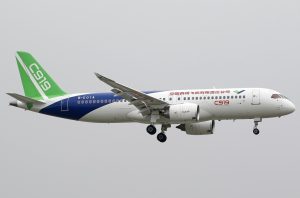At last week’s Paris Air Show, Chinese aerospace firms sought to reconnect with international partners while displaying an increasingly competitive array of commercial and military equipment. Having overcome zero COVID restrictions, the relatively pronounced Chinese presence at the show demonstrated renewed engagement, despite growing geopolitical tensions.
The Aviation Industry Corporation of China (AVIC), China’s leading state-owned aeronautics conglomerate, spearheaded China’s presence at the Paris Air Show. Jointly with its subsidiary China National Aero-Technology Import & Export Corporation, the AVIC booth displayed a growing array of relatively advanced civil and military aircraft, including models of the J-20 fifth-generation fighter and the JF-17 fourth-generation multirole fighter.
Official Chinese language coverage of the show emphasized the display of the J-20 as China’s most advanced fighter to date and the Y-20 as emblematic of Beijing’s ambition to improve the Chinese military’s air support and logistics capabilities.
According to reported statements from AVIC spokesperson Zhou Guoqiang, the firm aimed to “actively explore the international market” while in Paris. That was reflected in the large line-up of aircraft, including the debut of the aforementioned “20” series and the Wing Loong-10 medium-altitude long-endurance unmanned aerial vehicle, which was unveiled at the Zhuhai Air Show last November.
On the commercial side, representatives from the Commercial Aircraft Corporation of China highlighted the C919 single-aisle airliner, which completed its first commercial flight in May, hoping to present a competitive alternative to Western primes Airbus and Boeing in the short- and medium-haul sector.
With regard to space, China Aerospace Long March International represented the state-owned China Aerospace Science and Technology Corporation at the Paris Air Show. The subsidiary displayed models of the Long March series launch vehicles and communication satellites.
Apart from China’s state-owned aerospace primes, however, there were several start-ups and smaller companies at the show. CAS Space, for instance, aspires to become a leader in commercial spaceflight and launch services by adopting greater transparency than its state-owned peers to overcome political obstacles to cooperation with potential European partners. As a firm with mixed ownership, CAS Space demonstrates the pluralization of China’s high-technology aerospace industrial base as a growing array of private firms and those with mixed ownership form an increasingly diverse R&D ecosystem. This reflects Beijing’s commitment to harnessing growing capabilities in the private and commercial sectors for advances in strategically important industries such as space flight and launch infrastructure.
Despite growing diplomatic tensions between the West and China over Russian aggression toward Ukraine and the omnipresent Taiwan issue, China’s growing market for commercial aviation is still seen as an opportunity by stakeholders in Europe. Just in April, Airbus signed an agreement to build a second assembly line in China’s northeastern city of Tianjin for its A320 family, including the A321 exhibited in Paris. Similarly, MTU Aero Engines confirmed the success of its longstanding partnership with China Southern Airlines by building a second facility in China for engine disassembly, assembly and testing which should become operational by 2025.
In fact, it might be the distributed nature of aviation that enables cooperation in the long term, remarked Todd Siena, CEO of Block Aero Technologies, which offers blockchain-based supply-chain and asset management solutions for the aerospace sector with clients across Asia and the West.
“Aviation has long been an internationalized industry, as shown by the enduring footprint of Western aerospace majors in China,” Siena said. “One thing everyone can reach a consensus on is enhanced communication in safety and airworthiness matters. Emerging digital technologies, like blockchain, will play a critical role as facilitators of trusted communication.”

































